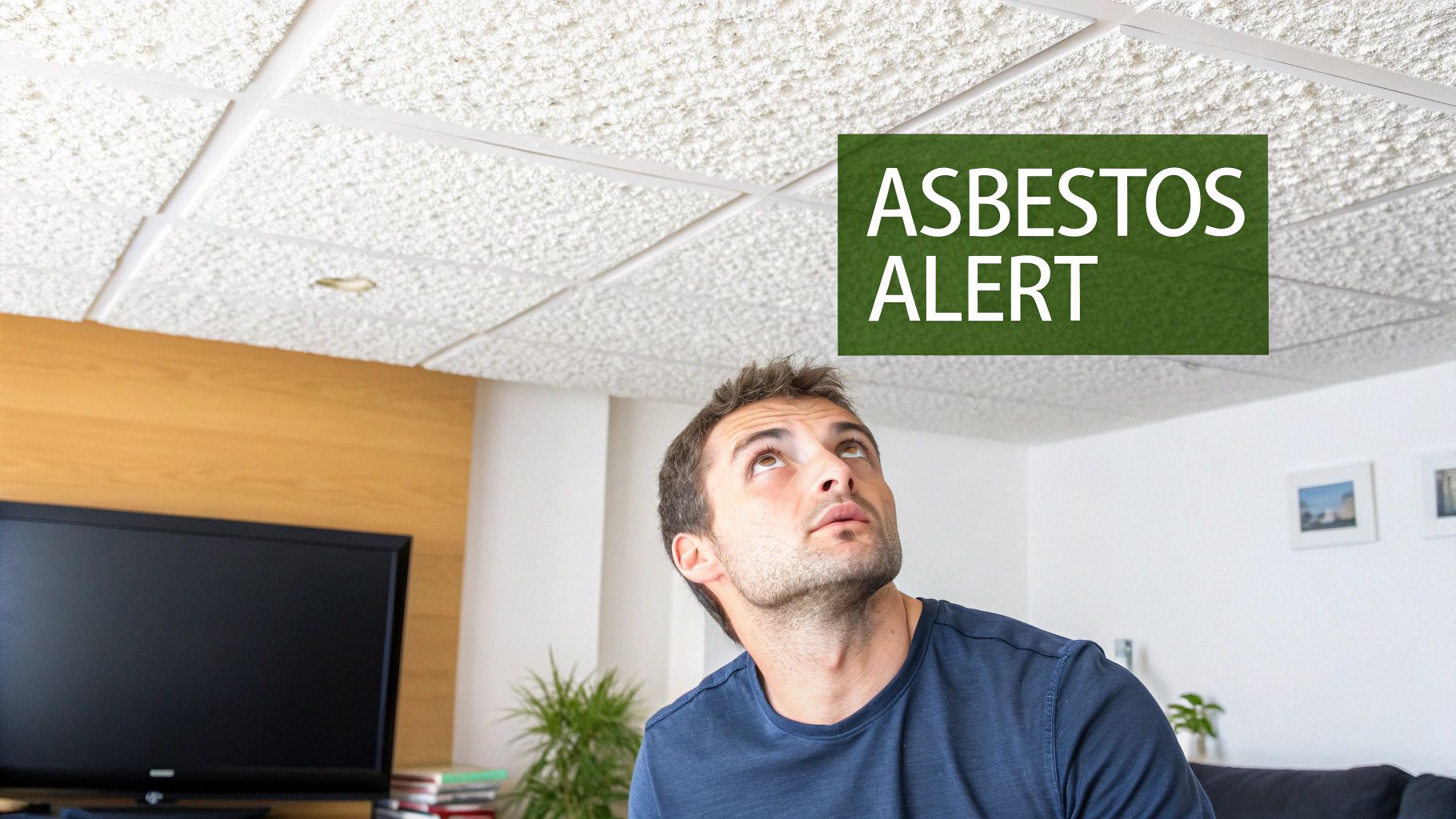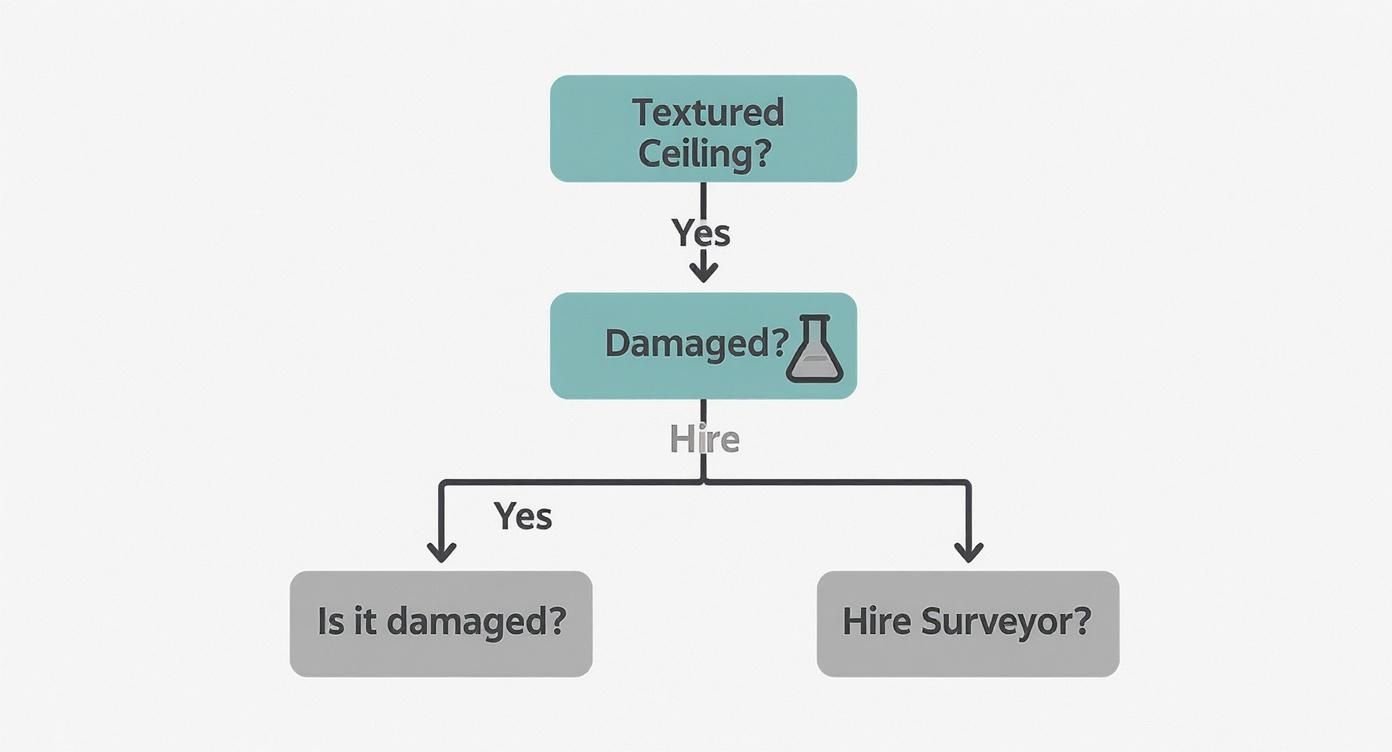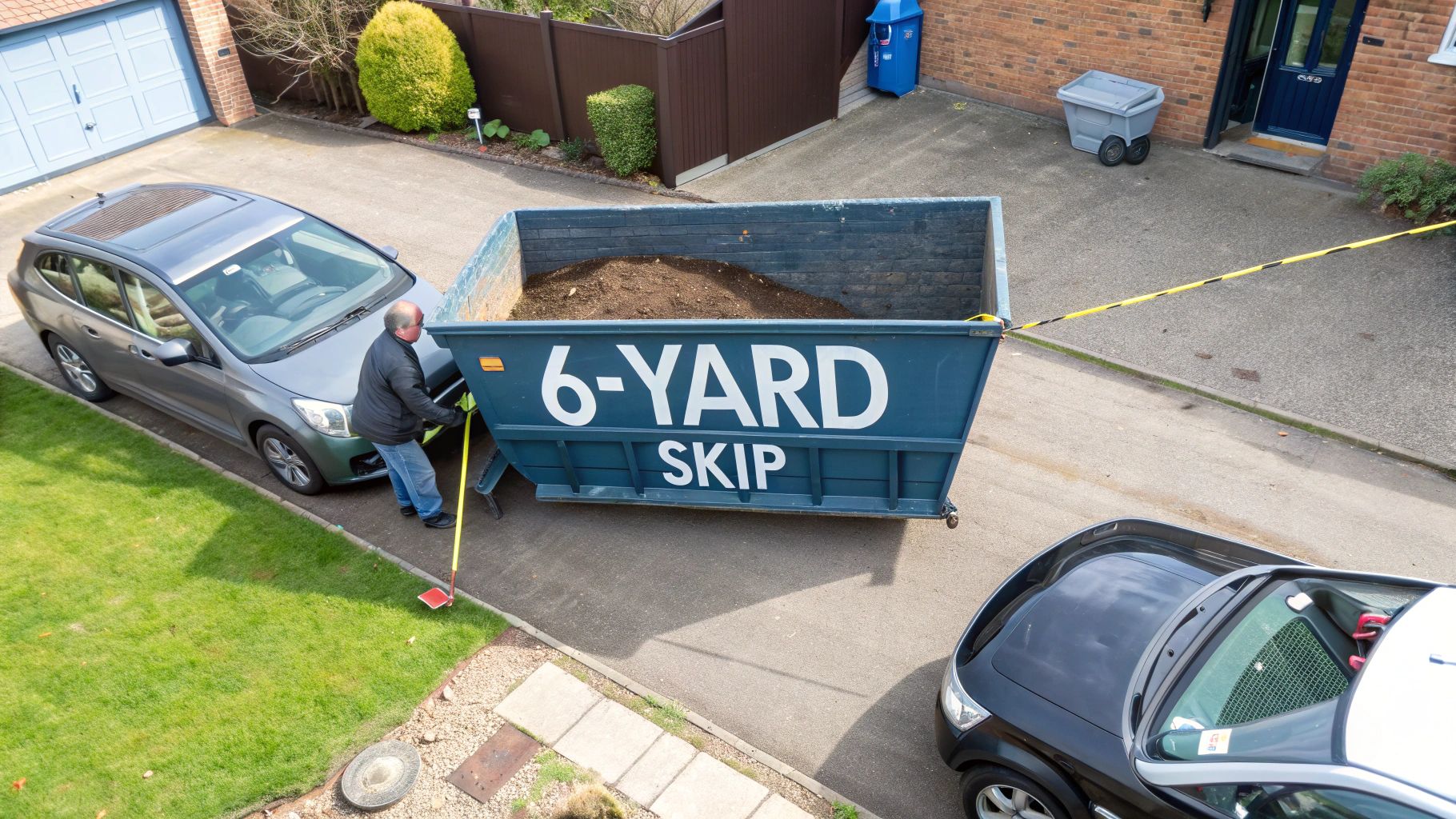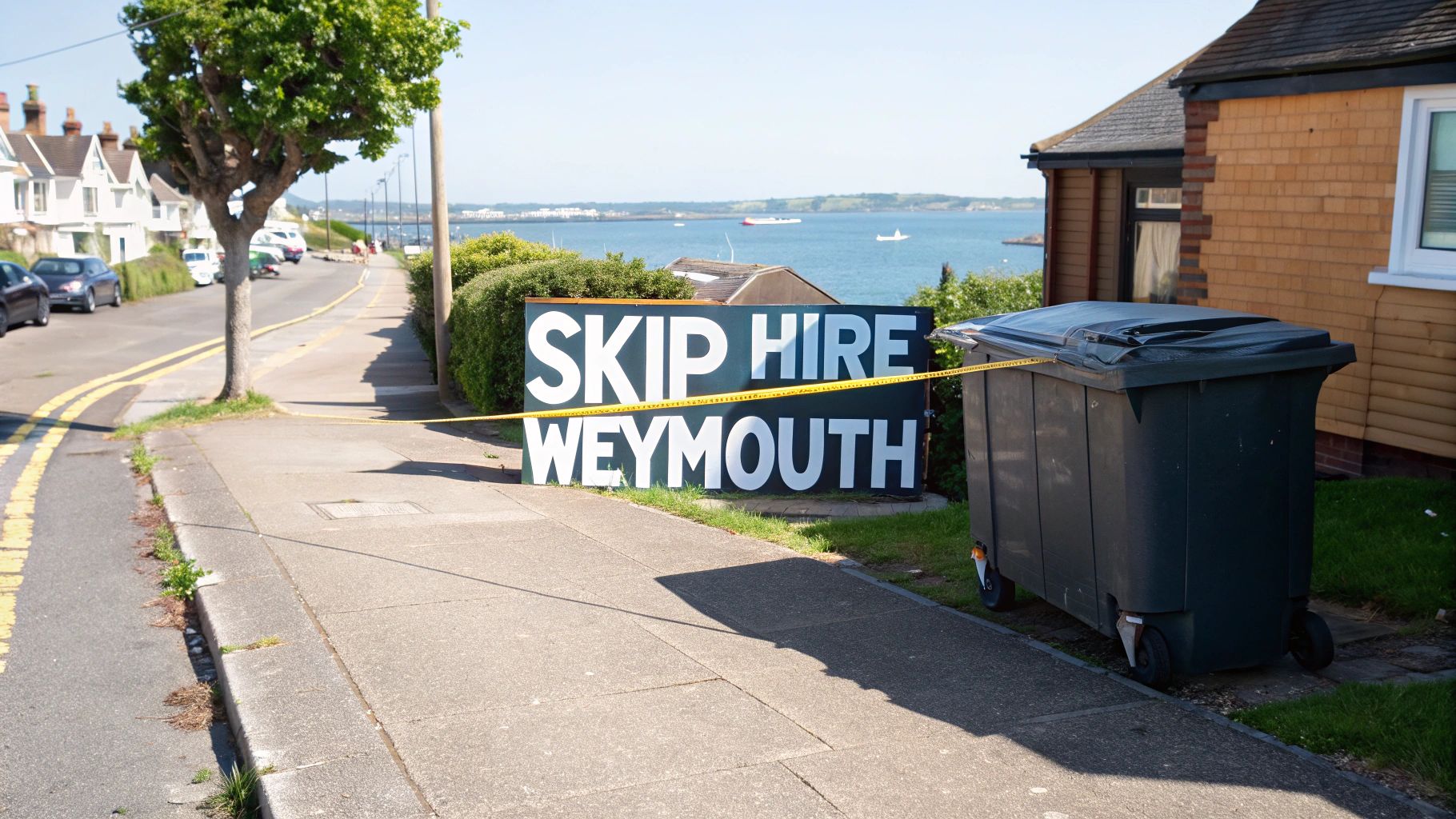How to remove asbestos ceiling safely: expert tips
How to remove asbestos ceiling safely: expert tips
That old textured ceiling, maybe an Artex one, can be a bit of a worry, especially if your home was built before 1999 when asbestos was finally banned in the UK. But here’s the most important thing to remember right off the bat: if it's in good condition and left alone, it's generally not an immediate danger. The real trouble starts when these materials get damaged, drilled into, or scraped, which is when microscopic fibres can be released into the air you breathe.
The Hidden Danger in Textured Ceilings
That swirly or stippled finish on your ceiling, once a very popular decorative choice, might be hiding asbestos. For decades, it was a go-to additive because it made plaster and other building materials stronger and more fire-resistant. The downside is that this practice has left a hazardous legacy in countless UK homes.

This lingering presence is far more common than most people think. Despite the ban, the material is still embedded in millions of buildings. In fact, surveys between late 2021 and early 2022 revealed that around 1.5 million UK buildings still contain asbestos-containing materials (ACMs).
Worryingly, domestic properties make up about 73% of these, with a shocking 86% of inspected homes found to contain ACMs. You can learn more about the scale of the issue by exploring these UK asbestos statistics and facts.
Understanding Friable vs Non-Friable Asbestos
It's helpful to know that not all asbestos materials carry the same immediate risk. The crucial difference is whether the material is ‘friable’ or ‘non-friable’.
- Friable Asbestos: This is the one to be most cautious of. It’s soft and can be easily crumbled or turned into a powder with just hand pressure. If a textured ceiling is damaged, it can become friable, releasing dangerous fibres with very little disturbance.
- Non-Friable Asbestos: Often called bonded asbestos, this is where the fibres are mixed with a bonding agent like cement. It's much more stable and won't release fibres unless it’s aggressively handled—think sawing, drilling, or suffering major damage.
A textured ceiling coating is usually considered non-friable when it's in good nick. The moment it starts to flake, crack, or degrade, however, its risk level changes completely.
The Real-World Health Risks of Disturbance
The real danger with asbestos comes from breathing in its microscopic fibres. Once they’re airborne, these tiny, needle-like particles can be inhaled and get lodged deep inside your lungs and other organs. Your body has no way to break them down or get rid of them.
Over many years, this exposure can lead to severe and often fatal diseases:
- Mesothelioma: A rare and aggressive cancer that affects the lining of the lungs and abdomen. Exposure to asbestos is its only known cause.
- Asbestos-Related Lung Cancer: Looks identical to lung cancer from smoking but is caused directly by inhaling asbestos fibres.
- Asbestosis: A chronic, non-cancerous lung disease that causes scarring of the lung tissue, which results in severe shortness of breath.
The core message is simple: the risk happens when it's disturbed. A planned renovation, drilling a simple hole for a new light fitting, or even water damage can turn a stable ceiling into an active health hazard.
This is precisely why a calm, informed, and safety-first approach is non-negotiable. Trying to remove an asbestos ceiling yourself without the right knowledge and professional gear isn't a weekend DIY project—it's a massive gamble with your health. Knowing when to stop and call in a licensed expert is the single most important decision you can make to protect yourself and your family.
How to Properly Identify and Test Your Ceiling
Before you even start thinking about how to remove an asbestos ceiling, you have to be absolutely sure that's what you're dealing with. When it comes to your family's health, guesswork is not an option, and I can tell you from experience that trying to identify asbestos just by looking at it is a fool's game.
Plenty of homes built or renovated from the 1950s right up to the late 1990s have textured coatings like Artex. You’ve probably seen the common patterns – swirls, stipples, and fans. While these are tell-tale signs of that era, they aren't definitive proof of asbestos. Many identical-looking, asbestos-free products were also on the market.
Visual Clues Are Not Enough
The age of your house is your biggest clue. If it went up before the year 2000, and especially before the mid-1980s, the chances of asbestos being present somewhere are much higher. But you can't confirm it with the naked eye.
The single most important rule is this: You can never identify asbestos just by looking at it. The fibres are microscopic, mixed right into the plaster or coating. Only a proper laboratory analysis can tell you for certain.
Relying on a visual check is a dangerous assumption. Sure, damage like cracks, flaking paint, or water stains makes the situation more urgent, but a perfectly intact ceiling doesn't mean it's asbestos-free.
Why DIY Sampling Is a Dangerous Mistake
You'll see DIY asbestos testing kits for sale online, but every safety expert will tell you to steer clear. The very act of taking a sample – scraping or cutting a piece of the ceiling – is exactly what releases those invisible, dangerous fibres into the air you breathe.
Without the right containment, breathing protection, and decontamination steps, you risk contaminating the entire room. It's a classic case of trying to save a few quid now, only to face potentially devastating health consequences down the line. For a deeper dive into this, our guide on identifying asbestos in your home has more crucial details.
The Professional Surveying Process
The only safe and legally compliant way to know for sure is to hire a UKAS-accredited asbestos surveyor. This guarantees the person taking the samples is trained, qualified, and follows strict safety protocols to stop any fibres from getting into the air.
Here’s what to expect when you book a professional survey:
- A Quick Chat: The surveyor will first ask about the age of your property and what work you have planned.
- Safe Sampling: They'll carefully cordon off the area, lay down protective sheeting, and get kitted out in the proper personal protective equipment (PPE).
- Minimal Disruption: A small sample is taken, usually after being wetted down to suppress dust. The spot is then immediately sealed up.
- Lab Analysis: The sample is securely double-bagged and sent off to a UKAS-accredited lab, where it's analysed under powerful microscopes.
The whole process is clean, safe, and usually very quick, giving you a definitive answer without the risk.
Management vs Refurbishment Surveys
The type of survey you need really depends on what your plans are. A good surveyor will guide you, but it helps to know the difference.
| Survey Type | Purpose and Scope | When It's Needed |
|---|---|---|
| Management Survey | A less intrusive check to locate and assess asbestos materials during normal occupation of the building. | Needed if you're a landlord or just want a map of any asbestos in your home without immediate plans for work. |
| Refurbishment/Demolition Survey | A fully intrusive survey that involves some destructive inspection to find all asbestos before any work begins. | This is the one you need if you plan to disturb or remove the ceiling. It’s a legal requirement. |
Understanding Your Lab Results
Within a few days, you’ll get a formal report back from the lab. The results are simple: it will either say "no asbestos detected," or it will identify the specific type found. For textured coatings, this is most often Chrysotile (white asbestos).
If the test comes back positive, your next call is to a licensed removal contractor. Now you'll have the official proof needed to get the job done safely and correctly.
Understanding UK Asbestos Laws and Regulations
Getting to grips with the rules around asbestos isn't just about following best practices; it's a legal minefield you absolutely have to navigate correctly. In the UK, the Control of Asbestos Regulations 2012 is the key piece of legislation governing any work that could disturb asbestos. And make no mistake, these rules aren't just for massive construction sites—they apply just as much to work in your own home.
https://www.youtube.com/embed/8hjcjBcX9HI
The law is built on one core principle: preventing exposure to airborne asbestos fibres at all costs. It lays out strict duties to manage these risks, protecting everyone from the tradespeople on the job to the family living in the property.
Homeowner and Landlord Responsibilities
While the legal framework covers everyone, your specific duties can vary a little depending on whether you're the homeowner or a landlord. Both roles, however, carry a significant duty of care.
If you’re a homeowner planning to tackle a project like removing an asbestos ceiling, the buck stops with you to ensure it's done safely. This means getting the material properly identified, hiring competent (and often, legally required licensed) professionals, and making sure the waste is disposed of correctly. You can't just chuck asbestos in the weekly bin.
For landlords, the responsibility is even more formalised. You have a legal obligation to assess and manage any asbestos in your rental properties to keep your tenants safe. This involves arranging surveys and taking swift, appropriate action if asbestos-containing materials (ACMs) are found, particularly if they’re in bad shape. Navigating the complexities of property safety can be daunting, and a comprehensive landlord survival guide can be an invaluable tool for ensuring you meet all your legal obligations.
The Three Categories of Asbestos Work
The Health and Safety Executive (HSE) doesn’t treat all asbestos work the same. It’s broken down into three categories based on the risk of releasing those dangerous fibres. This classification is critical because it dictates exactly who is legally allowed to do the job. Getting this wrong has serious health and legal consequences.
To help clarify things, here’s a simplified breakdown of the three legal categories for work involving asbestos. It should give you a good idea of when a licensed professional isn't just a recommendation, but a legal requirement.
UK Asbestos Work Categories Explained
| Work Category | Description & Risk Level | Typical Ceiling Example | Who Can Do It? |
|---|---|---|---|
| Licensed Work | Highest Risk. Involves easily crumbled (friable) materials like insulation board or coatings where fibres are easily released. | Scraping off a textured ceiling coating like Artex. The process creates significant dust and high fibre release. | Only an HSE-licensed contractor. |
| Notifiable Non-Licensed Work (NNLW) | Medium Risk. Work on less friable materials where fibre release is still a significant risk. The job must be notified to the HSE. | Removing a large area of damaged asbestos cement sheets from a garage ceiling. | Trained workers with medical surveillance. The work must be notified. |
| Non-Licensed Work | Lowest Risk. Involves stable materials where fibre release is unlikely if done correctly. | Carefully drilling a single, clean hole through an asbestos cement ceiling panel to fit a smoke alarm. | A competent person following strict precautions. No license or notification needed. |
Understanding these distinctions is the first step in planning any project. As you can see, the moment you start talking about scraping or disturbing a textured ceiling, you’re almost certainly in licensed territory.
This flowchart can help you visualise the very first steps in the decision-making process.

The key takeaway here is simple: if you see any damage on a ceiling you suspect contains asbestos, you need to stop right there and call a professional surveyor.
The Golden Rule When in Doubt
Figuring out which category your job falls into can be confusing. Is the material crumbling? How big is the area? What’s the overall condition? These are the questions that define the risk and, therefore, the legal path you must follow.
If you have any doubt at all about the type of asbestos or the level of risk, you must assume the work is licensed. It's the only safe and legally sound approach. Do not take a chance with this.
Trying to remove an asbestos ceiling yourself, or hiring a general builder who isn't licensed for high-risk work, is not just incredibly dangerous—it's against the law. The fines can be crippling, but worse, the health risks are permanent. For a deeper dive into your legal duties, our guide on hazardous waste disposal regulations offers more detail on compliant practices.
Your only move should be to step back and call a licensed asbestos removal contractor to get a professional assessment.
Finding and Vetting a Licensed Removal Contractor
So, you've had the tests back and the verdict is in: asbestos in the ceiling. The next decision you make is easily the most important one – choosing the right professional to get it out.
I can't stress this enough: this is not a job for your usual builder or the local handyman down the road. To safely remove an asbestos ceiling, you absolutely must hire a contractor with very specific training, credentials, and gear.

Your number one priority has to be checking they have a valid license from the Health and Safety Executive (HSE). This isn't just a bit of paper; it’s a legal must-have for high-risk work like dealing with textured coatings. It’s your proof that they know the protocols, have the right insurance, and can handle this dangerous material without putting your family at risk.
Building Your Shortlist
First things first, start searching for specialists in your local area. A fantastic starting point is the Asbestos Removal Contractors Association (ARCA) directory, which lists all their accredited members. Often, the surveyor who tested your ceiling can recommend reputable firms they trust. For more ideas, our guide on finding asbestos removal near you has some extra pointers for sourcing local experts.
Always aim to get quotes from at least three different companies. It’s not just about comparing the bottom line; it’s about seeing how they approach the job, what their timeline looks like, and the general feel you get from their professionalism.
A massive red flag? Any contractor offering a quote over the phone without visiting your home. A true professional will always insist on a site visit to properly assess the job, understand the risks, and see what your property requires.
Critical Credentials to Verify
Before you even start talking money or dates, you need to see proof of their qualifications. Any trustworthy contractor will have these documents ready and will be happy to show you.
- HSE Licence: Ask for their license number and check it yourself on the HSE's public register. This is completely non-negotiable.
- Specialist Insurance: They need public liability insurance that specifically covers licensed asbestos work. Your standard builder’s insurance won’t cut it.
- Waste Carrier's Licence: They must be legally registered to transport hazardous materials. Again, ask for their licence number.
- Evidence of Training: Check that their team members have current training certificates for asbestos removal.
Doing these initial checks is the quickest way to weed out the cowboys and unqualified operators, saving you from a world of health risks and potential legal trouble.
Key Questions to Ask Every Contractor
Once you’re happy with their credentials, it's time to get into the nitty-gritty of how they work. The way they answer these questions will tell you everything you need to know about their expertise and their commitment to safety.
Here’s what you should be asking:
- What containment methods will you use? They should be talking about a fully sealed enclosure with negative pressure units to stop a single fibre from escaping.
- How will you manage air monitoring? The answer should involve a separate, UKAS-accredited analyst conducting air tests before they start, during the removal, and after they finish.
- What is your decontamination process? They need to describe a clear, multi-stage process for their team and equipment to exit the contained area safely.
- How will you dispose of the asbestos waste? The correct procedure is to double-bag it, label it clearly, and transport it to a licensed hazardous waste facility.
- Will I receive a waste consignment note? This document is your legal proof that the asbestos was disposed of correctly. You must get a copy for your records.
- Will I get a certificate of reoccupation? Once the final air test comes back clear, the independent analyst issues this. It's the official document declaring the area is 100% safe to use again.
Comparing Quotes The Right Way
When you get the quotes back, don't just jump at the cheapest price. A quote that's significantly lower than the others is often a warning sign that corners are being cut, whether it’s on safety gear, proper containment, or compliant disposal.
Instead, lay the quotes out side-by-side and compare the detail in their plan of work. The best quote will be thorough, outlining every single step from setting up the enclosure to the final clearance certificate. There should be no grey areas. By choosing competence and safety over cost, you can hire an expert with confidence, knowing the job will be done right.
Breaking Down Asbestos Removal Costs and Timelines
So, you've had the confirmation: there’s asbestos in your ceiling. The next logical thoughts are always, "how much is this going to cost?" and "how long will it take?" Let's be honest, it's a significant home safety project, so getting a clear picture of the budget and schedule is crucial for your peace of mind. The price to remove an asbestos ceiling isn't just one number; it’s a combination of several essential, non-negotiable safety services.

When you get a professional quote, it will bundle together a few distinct but vital expenses. You're paying for the initial asbestos survey, the highly skilled labour of licensed specialists, setting up a completely sealed containment area, and the use of specialised gear like negative pressure units. Of course, it also covers the legally compliant disposal of all that hazardous waste.
Key Factors Influencing Your Final Bill
No two removal jobs are the same, and a few key variables can really shift the final cost. A contractor will pop round to assess these things during a site visit before they put together a detailed quote for you.
Here's what they'll be looking at:
- Size of the Area: This is the big one. The total square meterage of the ceiling is the main cost driver. A small bathroom ceiling is one thing, but a large, open-plan living room is a completely different scale of project.
- Accessibility: How easy is it to get to the ceiling? If you've got high or vaulted ceilings, the job might require specialised scaffolding, which adds to the labour time and equipment costs.
- Type of Asbestos: The condition of the asbestos-containing material (ACM) and what type it is can change the removal method, which in turn affects the price.
- Air Monitoring: This is a critical safety step that can't be skipped. Independent air testing before, during, and after the job is a separate cost that has to be factored into the overall budget.
It's important to realise that the cost of asbestos ceiling removal in the UK varies widely. As a ballpark, domestic removal prices average around £225 per square metre. For a more specific job, like removing an Artex ceiling from a 10m² room, you could be looking at a range anywhere from £300 to £1,200.
When you're planning the project, don't forget it's a major home improvement. Using a detailed renovation checklist for your property can be a lifesaver, helping you remember all the little details, including what to do with your furniture and belongings while the work is happening.
What a Typical Project Timeline Looks Like
While every job has its own quirks, the timeline for a professional asbestos ceiling removal follows a very structured, predictable path. This isn't a task that can be rushed; every single stage is vital to ensure your home is left completely safe.
Here’s a general idea of what to expect from start to finish:
- Initial Survey and Quoting (1-3 days): Once you make that first call, a contractor will visit to assess the situation. You'll then get detailed quotes to compare.
- Scheduling and Notification (1-2 weeks): This is a big one. For licensed asbestos work, the contractor is legally required to notify the HSE at least 14 days before they can start. It's a mandatory waiting period.
- Site Setup and Removal (1-3 days): For a typical room, the team will likely spend the first day setting up the sealed enclosure and the decontamination unit. The actual removal work might take another day or two after that.
- Air Testing and Clearance (1 day): An independent analyst comes in to conduct the final air tests. As soon as the results come back clear, they'll issue a certificate of reoccupation, which is the official document declaring the area safe to use again.
All in all, from your first phone call to getting that all-clear certificate, a standard residential ceiling removal project can take roughly three to four weeks. That mandatory HSE notification period is a big chunk of the timeline, so it’s important to factor it in.
Got Questions About Asbestos Ceiling Removal?
Even when you have a plan, just the word "asbestos" can throw up a lot of questions. It's totally normal to feel a bit swamped by the technical jargon, safety rules, and potential costs. We get it. This section is here to give you clear, straight-up answers to the most common queries we hear from homeowners dealing with a dodgy ceiling.
Think of this as your quick-fire Q&A. We’ll get straight to the point on the most urgent questions, clearing up any confusion and helping you feel more confident about your next steps.
Is It Safe to Live in a House with an Asbestos Ceiling?
This is often the first thing people ask, and thankfully, the answer is usually reassuring. If your textured ceiling is in good nick—meaning it isn't cracked, crumbling, or flaking—it’s generally considered safe to live with. The asbestos fibres are locked tightly within the ceiling material and aren't getting into the air you breathe.
The real danger kicks in when that material gets disturbed. This could be anything from a leak causing it to degrade, drilling a hole for a new light fitting, or scraping it back during a renovation. If it's intact and you leave it well alone, the risk is minimal.
How Can I Tell for Sure If My Ceiling Has Asbestos in It?
While the age of your house is a massive clue (anything built before the mid-1980s is a prime suspect), you can never tell just by looking. Plenty of modern, asbestos-free textured coatings look identical to the dangerous old stuff. The only way to know for certain is to get it tested by a lab.
Whatever you do, don't try to take a sample yourself. Scraping or breaking off a piece of a potential asbestos ceiling is one of the most hazardous things you can do, as it guarantees you’ll release those harmful fibres into the air. Always, always hire a UKAS-accredited professional to take a sample safely.
Can I Just Paint Over or Cover an Asbestos Ceiling?
Sometimes, yes. Covering an asbestos ceiling, a process called encapsulation, can be a good management strategy. This usually involves plastering over the existing texture or fixing a new layer of plasterboard underneath it. Done right, this method seals the asbestos in place, preventing fibre release.
But it’s not a simple fix, and there are a few critical things to think about:
- Condition is Everything: This is only an option if the ceiling is in excellent, stable condition. You can’t safely cover a ceiling that's already damaged or falling apart.
- Think About the Future: The asbestos is still there, just hidden. Any future homeowner or tradesperson who drills into that ceiling will be unknowingly exposed. It has to be properly documented.
- Weight and Structure: Adding a layer of plasterboard and a skim coat adds a lot of weight. You'll need a surveyor to confirm the original ceiling structure can actually handle it.
Encapsulation can be a safe alternative to full removal, but it's not a weekend DIY job. It needs careful planning and professional work to make sure the asbestos isn't disturbed while the new covering goes up.
Would a House Built in 1990 Have an Asbestos Ceiling?
It’s much less likely, but not completely impossible. Most asbestos products were phased out during the 1980s, but the final UK ban on Chrysotile (white asbestos), the type most commonly used in ceiling coatings, didn't come into force until 1999.
It wasn't unheard of for builders in the early 90s to use up old stock they still had lying around. So, while a house from the 1990s is at a much lower risk than one from the 1970s, you can't be 100% certain without a test. If you’re planning any work that could disturb it, getting it checked is always the smartest move.
What Should I Do If I Accidentally Damage an Asbestos Ceiling?
If you've accidentally drilled a hole or knocked a crack in a ceiling you think might contain asbestos, the first thing to do is not panic. The second is to act fast to contain the area and stop the fibres from spreading.
Here’s your immediate action plan:
- Stop Work Straight Away: Down tools. Don’t do anything else in that room.
- Clear the Room: Get everyone out and shut the door behind you.
- Seal It Off: Wedge a damp towel or cloth at the bottom of the door to help stop fibres from escaping.
- Don’t Touch the Debris: Do not try to sweep or vacuum it up. That's the worst thing you can do, as it will just puff the fibres up into the air.
- Call in the Pros: Contact a licensed asbestos removal company immediately. They’ll tell you exactly what to do next, which will almost certainly involve a professional decontamination and air testing.
Navigating the complexities of asbestos removal requires expert guidance and compliant disposal. At The Waste Group, we offer specialist asbestos collection and disposal services, ensuring all hazardous materials from your project are handled safely and legally. Find out more about our compliant disposal solutions at https://www.thewastegroup.co.uk.


